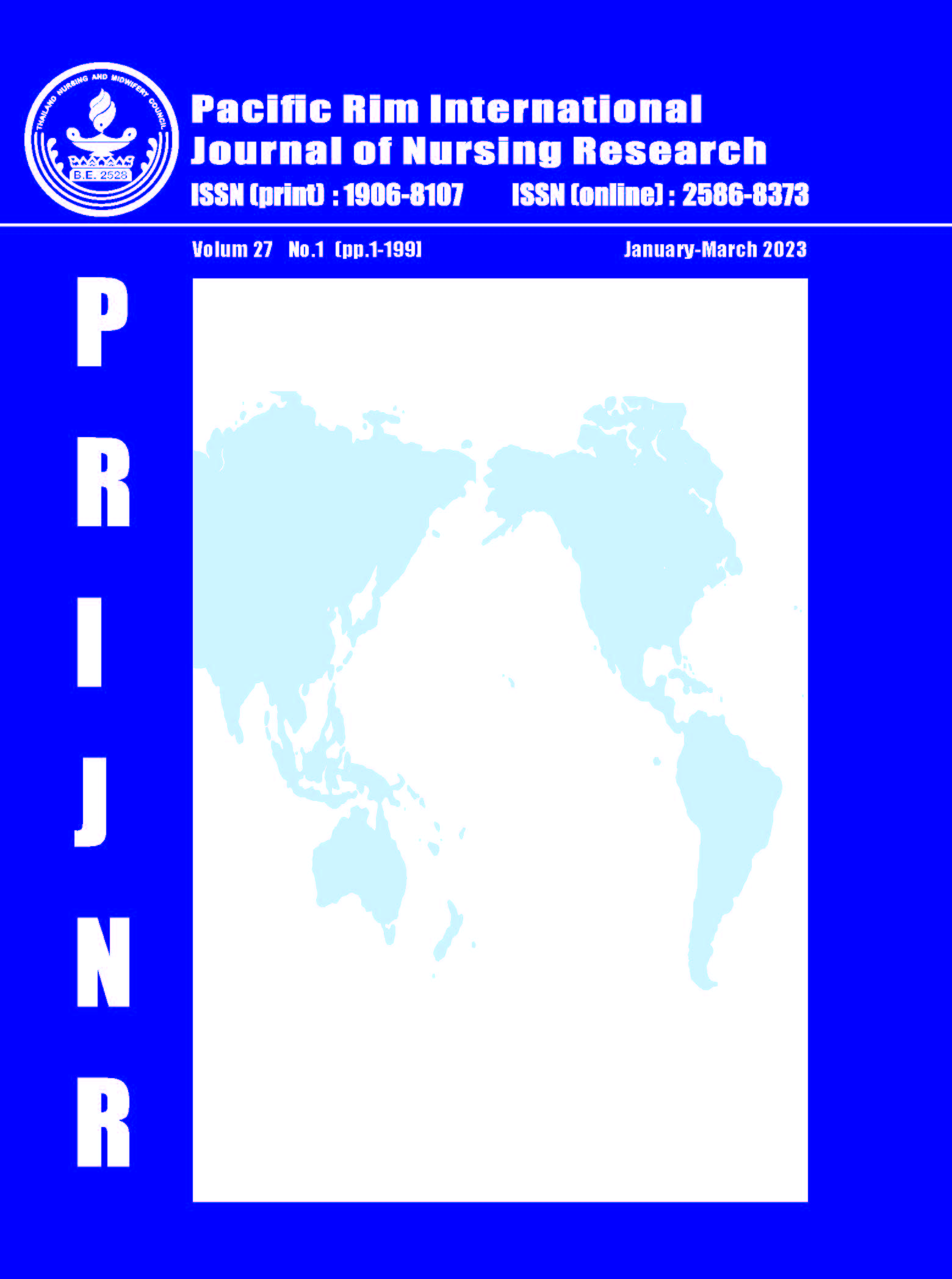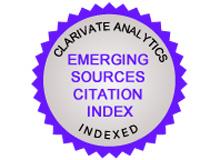Factors Predicting Intention to Use Contraceptive Implants Among Pregnant Adolescents in Lower Southern Thailand: A Cross-sectional Study
DOI:
https://doi.org/10.60099/prijnr.2023.260339Keywords:
Attitude , Contraceptive implants, Fear , Adolescents’ intention to drink, Knowledge, Life goal settings, Perceived behavioral control, Pregnant adolescent , Subjective normsAbstract
Repeat pregnancy among adolescents is a major problem which affects maternal health, families, and the country. The repeated pregnant adolescent rate in Thailand is still higher than 10%, the goal of the Ministry of Public Health. It has been found that the occurrence of repeat pregnancies among adolescents is higher in lower southern Thailand than in any other region of the country. This cross-sectional study examined the level of intention to use contraceptive implants and its influencing factors among pregnant adolescents. Participants were 319 pregnant adolescents who received antenatal care at three secondary care hospitals and one tertiary care hospital in lower southern Thailand. The instruments used to collect data included eight questionnaires: (1) Demographic and Obstetric Data Form, (2) Attitude Toward Contraceptive Implants Questionnaire, (3) Subjective Norm Toward Contraceptive Implants Questionnaire, (4) Perceived Behavioral Control Toward Contraceptive Implants Questionnaire, (5) Knowledge about Contraceptive Implants Questionnaire, (6) Life Goal Setting Scale, (7) Fear of Side Effects of Contraceptive Implants Questionnaire, and (8) Intention to Use Contraceptive Implants Questionnaire. Data were analyzed using descriptive statistics, Pearson’s correlation test, and simultaneous multiple regression analysis.
The result showed that intention to use contraceptive implants was at a moderate level. Perceived behavioral control toward contraceptive implants was the strongest predictor overall, which together with attitude toward contraceptive implants and subjective norm toward contraceptive implants, significantly explained 34.4% of the variance in intention to usecontraceptive implants. The results of this study could serve as a basis for developing nursing programs to promote intention to use contraceptive implants in pregnant adolescents in lower southern Thailand by providing them with positive attitudes and perceived behavioral control regarding intention to use contraceptive implants, along with coordination with family members who support the use of contraceptive implants.
References
The Annie E. Casey Foundation. Repeat teen pregnancies in Maine [Internet]. 2022 [cited 2022 June 1]. Available from: https://datacenter.kidscount.org/data/bar/ 9913-repeat-teen-pregnancies?loc=21&loct=2#2/any/false/574/any/19250
Ministry of Public Health, Thailand. Statistics of repeat pregnancy rate in women aged under 20 years in area health [Internet]. 2021 [cited 2022 May 30]. Available from: http://dashboard.anamai.moph.go.th/dashboard/repregnancy/index?year=2021
Ministry of Public Health, Thailand. Statistics of postpartum and post-abortion contraceptive use among women aged under 20 years [Internet]. 2021 [cited 2022 May 30]. Available from: https://dashboard.anamai.moph.go.th/dashboard/laborfpnormal20/index?year=2021
Act For Prevention and Solution of the Adolescent Pregnancy Problem, B.E. 2559. (2016, 30th March). The Government Gazette [Internet]. 2016 [cited 2020 Feb 13]. Available from: http://law.m-society.go.th/law2016/law/view/773 (in Thai)
Bureau of Reproductive Health, Department of Health. Teenage pregnancy surveillance report, 2020 [Internet]. 2020. [cited 2022 May 29]. Available from: https://rh.anamai.moph.go.th/th/surveillance-report/2515 #wow-book/ (in Thai)
Hanson JD, Nothwehr F, Yang JG, Romitti P. Indirect and direct perceived behavioral control and the role of intention the context of birth control behavior. Matern & Child Health J. 2015;19:1535-42. doi:10.1007/s10995-014-1658-x
Plodpluang U. Experience of repeat pregnancy prevention among adolescents. JOHSS [Internet]. 2021[cited 2022 June 1];8(1):34-50. Available from: https://he01.tci-thaijo.org/index.php/johss/article/view/245402 (in Thai)
Wattanathamrong V, Sirisopon N, Kainakha P, Onsiri S, Amitpie C, Achariya A, et al. Factors related intention contraception type implants in repeat pregnanciesadolescents. JRTAN [Internet]. 2017 [cited 2022 June 1];18(Suppl): 102-11. Available from: https://he01.tci-thaijo.org/
index.php/JRTAN/article/view/90108/70831 (in Thai)
Ajzen I. The theory of planned behavior. Elsevier Sci. 1991;50(2):179-211. doi: 10.1016/0749-5978(91) 90020-T.
Duangchan C, Wattanakorn K, Teanchaithut C, Sriyasak A, Oumpram K. The factors predicting intention to prevent teenage pregnancy among female junior high school students. SCNJ [Internet]. 2019 [cited 2022 June 1];6(Suppl):15-28. Available from: https://he01.tci-thaijo.org/index.php/scnet/article/view/175676/153766 (in Thai)
Jantarasiew B, Boonyaporn T. Teenage mothers in postpartum period at Trang hospital: attitudes, subjective norms, perceived behavioral control, and intention to use contraception. SCNJ [Internet]. 2019 [cited 2022 June 1];6(1):143-53. Available from: https://he01.tci-thaijo.org/index.php/scnet/article/view/154340/119834 (in Thai)
Kruangkaew P, Phahuwatanakorn W, Pungbangkadee R. Predictability of knowledge, attitude, subjective norm and perceived behavioral control on intention to the use of long-acting reversible contraception among primipara pregnant adolescents. Thai J Nurs Res. 2021;39(1):64-76 (in Thai).
Chacko MR, Wiemann CM, Buzi RS, Kozinetz CA, Peskin M, Smith PB. Choice of postpartum contraception: factors predisposing pregnant adolescents to choose less effective methods over long-acting reversible contraception. J Adolesc Health. 2016;58(1):628-35. doi: 10.1016/j.jadohealth.2015.12.002.
Gebeyehu NA, Lake EA, Gelaw KA, Azeze GA. The intention on modern contraceptive use and associated factors among postpartum women in public health institutions of Sodo Town, Southern Ethiopia 2019: an institutional-based cross-sectional study. BioMed Res Int.
;2020;9815465. doi: 10.1155/2020/9815465.
Somroop A, Deoisres W, Suppaseemanont W. Factors influencing the use of postpartum contraceptive implants among primiparous adolescents. JFONUBUU [Internet]. 2019 [cited 2022 June 1]; 27(3):79-87. Available from: http://ojslib3.buu.in.th/index.php/nursing/article/
view/6529 (in Thai)
Strategy and Information Sub-committee in the 12th Public Health Region. Government action plan in health region 12 for annual budget 2020. [Internet]. 2020 Feb. [cited 2022 Nov 5]. Available from: http://www.rh12.moph.go.th/news/cio_meeting_5_2562/ (in Thai)
Hayimaming H, Masamae I. Study the understanding about Islamic contraception of married couples in Charolaeko community, Narathiwat province. M-JICI. 2021;2(2): 25-36 (in Thai).
Dilawar B. Birth control [Internet]. 2022 [cited 2022 Nov 5].Available from: https://www.al-islam.org/islamic-edicts-family-planning/birth-control
Berhe R, Nigusie A. Intention to use long acting contraceptive method and associated factors among women currently using short acting contraceptive methods in Gondar city, northwest Ethiopia: using the theory of planned behavior. Res Sq. 2020: 1-16. https://doi.org/10.21203/rs.3.rs-23589/v1
Kuasit U, Chunuan S, Hatthakit U, Bullock LF. The effects of the resilience-enhancing nursing program on life goals among pregnant teenagers: a randomized controlled trial. Songklanagarind J Nurs. 2018;38(1):35-45.
Claringbold L, Sanci L, Temple-Smith M. Factor influencing young women’s contraceptive choice. Aust J Gen Pract. 2019; 48(6):389-94. doi: 10.31128/AJGP-09-18-4710.
Babalola S, John N, Ajao B, Speizer IS. Ideation and intention to use contraceptives in Kenya and Nigeria. Demogr Res. 2015;33(1): 211-38. doi:10.4054/DemRes.2015.33.8.
Enhancing the Quality and Transparency Of health Research. The strengthening the reporting of observational studies in epidemiology (STROBE) statement: guidelines for reporting observational studies [Internet]. 2022 [cited 2022 May 30]. Available from: https://www.equator-network.org/reporting-guidelines/strobe
Kieser M. Methods and applications of sample size calculation and recalculation in clinical trials. 1st ed. New York: Springer; 2020. 410 p.
Negewo D. Assessment of factors affecting women’s intention to use long acting and permanent contraceptive methods among family planning clients of public health facilities in Ambo town, Oromia national regional state, Ethiopia [master’s thesis]. [Ethiopia]: Addis Ababa
University; 2010. 81 p.
Twenge JM, Campbell WK, Freeman EC. Generational differences in young adults’ life goals, concern for others, and civic orientation. J Pers Soc.Psychol. 2012;102(5): 1045-62. doi: 10.1037/a0027408.
Simmonds P. Linear regression analysis primary agreement’s test. JRCD [Internet]. 2017 [cited 2022 May 30];7(2): 20-37. Available from: https://so03.tci-thaijo.org/index.php /jrcd/article/view/115566 (in Thai)
Chernthong P, Saibuppha S. Contraception among teenage pregnancy in Health Region 1. Lanna JHEHP [Internet]. 2019 [cited 2022 May 30];10(2):52-66. Available from: https://he01.tci-thaijo.org/index.php/lannaHealth/article/view/250344 (in Thai)
Ahinkorah BO, Budu E, Aboagye RG, Agbaglo E, Arthur-Holmes F, Adu C, et al. Factor associated with modern contraceptive use among women with no fertility intention in sub-Saharan Africa: evidence from cross-sectional surveys of 29 countries. Contracept Reprod Med. 2021;6(1):22. doi: 10.1186/ s40834-021-00165-6.
Bangoura C, Dioubate N, Manet H, Camara BS, Kouyate M, Douno M, et al. Experiences, preferences, and needs of adolescents and urban youth in contraceptive use in Conakry, 2019, Guainea. Front Glob Women’s Health. 2021;2:655920. doi: 10.3389/fgwh.2021.6 55 920.
DeMaria AL, Sundstrom B, Faria AA, Saxon GM, Ramos-Ortiz G. Using the theory of planned behavior and self-identity to explore women’s decision-making and intention to switch from combined oral contraceptive pill (COC) to long-acting reversible contraceptive (LARC). BMC Women’s Health. 2019;19(1):82. doi: 10.1186/s12905 -019-0772-8.
Chen H, Song H, Li M, Hu S, Xiong X, Jiang H, et al. The impact of awareness and attitudes towards long-action reversible contraceptives on the intention to use: a survey among youth with unintended pregnancies. Eur J Contracept Reprod Health Care. 2022;27(2):121-6.
doi: 10.1080/13625187.2022.2029396.
Tukue D, Gebremeskel TG, Gebremariam L, Aregawi B, Hagos MG, Gebremichael T, et al. Prevalence and determinants of modern contraceptive utilization among women in the reproductive age group in Edaga-hamus town, Eastern zone, Tigray region, Ethiopia, June 2017. PLos ONE. 2020;15(3):e0227795. doi: 10.1371/journal.pone.0227795
Saengprajongb K, Ratinthon A, Phahuwatanakorn W. Effects of motivational counseling on readiness for long-term contraceptive use in pregnant adolescents: a pilot study.J Nurs Sci. 2016;34(Suppl1):28-39 (in Thai).
Intharueang U, Masingboon K, Wacharasin C. A causal model of contraceptive behavior among female adolescents. JNHC [Internet]. 2015 [cited 2022 May 30];33(4):43-53. Available from: https://he01.tci-thaijo.org/index.php/jnatned/article/view/49003/40695 (in Thai)
Downloads
Published
How to Cite
Issue
Section
License
Copyright (c) 2022 Pacific Rim International Journal of Nursing Research

This work is licensed under a Creative Commons Attribution-NonCommercial-NoDerivatives 4.0 International License.
Copyright: The Pacific Rim International Journal of Nursing Research, Thailand Nursing & Midwifery Council has exclusive rights to publish, reproduce and distribute the manuscript and all contents therein.








.png)



